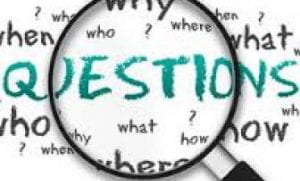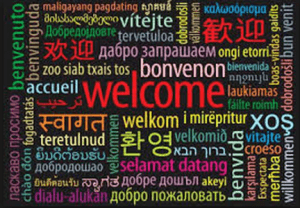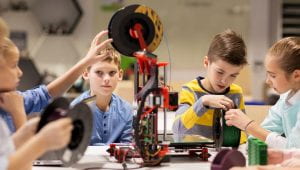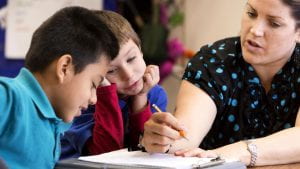 Traditional education has mainly focused on linearly transmitting information, from teacher to student, with the product being an assessment of what the student “knows.” However, when the class moves in a linear A-B-C-D fashion, information and concepts which are missed may go unnoticed. In order to expose gaps in knowledge and skill a new way of digesting material must be introduced. The C3 Inquiry method proposes just this kind of change.
Traditional education has mainly focused on linearly transmitting information, from teacher to student, with the product being an assessment of what the student “knows.” However, when the class moves in a linear A-B-C-D fashion, information and concepts which are missed may go unnoticed. In order to expose gaps in knowledge and skill a new way of digesting material must be introduced. The C3 Inquiry method proposes just this kind of change.
Ever since learning of the C3 Inquiry method, I’ve been a fan. I recently created a lesson which utilized the C3 Inquiry: “What Influenced the Creation of the U.S. Constitution?” located at http://www.c3teachers.org/wp-content/uploads/2016/06/C3-FINAL-Gov-Constitutional-Influences.pdf, Inquiry material created by Fairfax County Public Schools.
As I walked through the lesson plan, I began to realize, I was getting ahead of myself. Most students are not exposed to the inquiry method and if they are, I’m not sure they realize its purpose. Since I believe purposeful instruction is the key to student engagement and motivation, I began to really think through how I would introduce this method to my class. “How should I explain this?”, “Should I have a pre-review of the activity before I explain its purpose?”, or “Should I just introduce it “cold” and work through the explanation as the lesson progresses?”.
Although some of my answer(s) will come from the culture of the individual class, I came to the conclusion —it was best to begin at the beginning. I will introduce the C3 Inquiry lesson to the students by telling the students that we are going to engage in a C3 Inquiry and explain to them “why” we are going to engage in this method.
In my explanation of the “why”, I will point out that:
- C3 often takes students out of their comfort zones (because students are used to direct instruction),
- C3 stretches learning and provides many avenues to “show what you know”,
- C3 at its base prods students to ask questions and construct their own responses,
- C3 will help students think of the content in ways not before considered,
- C3 will help students learn “how” to ask their own questions, how to frame the questions, and how to ask the right questions; and,
- C3 trains students to be “question askers” and not just “question answerers”
For all of C3’s benefits it is also important to realize that even with the explanation of the process, the introduction of this foreign learning concept may give some students cause for pause.
That’s why probing students with open-ended questions, using student generated questions to drive additional thought, and forcing the use of evidence to support concepts, answers, and additional questions are keys to expanded thinking through Inquiry.
However, these techniques as well as “question asking” in isolation does not turn students into critical thinkers — this is why I will take care in being selective about the student questions I answer; to allow students to remain in the driver seat of the C3 lesson.
In addition, I will strive to share my own annotations to the Inquiry, showing students I’m learning with them, that I have questions too, and that I use the Inquiry method to help me process information.
In the end, I see myself using this inquiry method in my future classroom to deepen understanding of the various factors at play in the media both past and present, meeting SOL skills standards, and fulfilling Virginia Portrait of a Graduate requirements. I envision doing this by breaking the students up into discussion groups where they can fully apply the different thinking processes happening simultaneously during the Inquiry. Education is evolving, and a modern society deserves a modern way of thinking, a way of changing the dialogue from “what we know” to “how we know.”
 A foundational premise of student success lies in parent support and involvement at the school. Often times, parents are not involved in the educational process as much as they may like and although there are a myriad of reasons why involvement may be lacking, it is important to get parents on-board.
A foundational premise of student success lies in parent support and involvement at the school. Often times, parents are not involved in the educational process as much as they may like and although there are a myriad of reasons why involvement may be lacking, it is important to get parents on-board.
In an effort to overcome individual difference variables and events outside of a single teacher’s control, a specific communication improvement strategy that could be employed to improve the teacher-parent partnership would be to ‘touch’ parents often.
Having accessible information is excellent and providing a weekly re-cap is equally informative, however, engaging parents briefly and individually, may be the best strategy when other methods have proven unsuccessful. Taking a small moment to send a personal, positive communication note to the parent concerning their child can go a long way. This may look like:
- A “Catching Students Being Good” e-mail,
- An e-mail praising the work of a student who was successful in a challenging area; and,
- A generalized note telling the parent the teacher knows their child, knows them, and is there for both of them during the school year.
Some parents may delete these messages, which merely means the communication was not impactful to them – and that is ok. However, for some parents, it will make a world of difference in creating a true partnership between home and classroom.
Simply stated, reach out the parents; let them know their student is more than a student name and number on your roll. Invite parents into your classroom – in whatever way your district will allow you too. Allow parents to be as involved as they want in what is happening in the classroom with their children; your students.
I believe in communication equity, classroom transparency, and parent partnership. When a parent is involved, the overreaching rewards to the school, the classroom, and the student are so fruitful, it can hardly be afforded not to invest the time to foster those mutual relationships.
 There is no question that communication is important in the classroom; however, it cannot be overlooked that communication by teachers to parents is equally important to the success of the student.
There is no question that communication is important in the classroom; however, it cannot be overlooked that communication by teachers to parents is equally important to the success of the student.
In short, everyone benefits from increased teacher-parent communication.
When teachers communicate, parents are better able to understand the educational system — how the program(s) work, which allows them to craft better home strategies to support students. When parents know how things work, they feel a greater sense of empowerment. When the mystery is removed, trust is built, and parents become stakeholders and not adversaries or skeptics of the school.
Often parents are not as involved as they would like to be and there are a myriad of reasons. However, at its core, countless parent interviews have told me the answer of parent involvement lies in (1) an understanding of the environment itself and (2) resource constraints. When parents are not involved the reasons typically looks like:
- Lack of accommodation for working parents’ schedule(s) when hosting school events or meetings,
- Childcare constraints,
- Lack of understanding related to a parent’s communication style, background, or abilities making the parent feel unwelcome or isolated,
- Input has not been solicited from parents on issues within the school’s control—preventing buy-in,
- Past tensions between the parent(s) and the school/teacher(s); and,
- A shortage of opportunity for parents to be involved in upper school grades.
An overarching strategy for improving teacher-parent communication is to get parents involved—early, and often. Research has shown that when parents are involved, it is for the better—better engagement, better attendance, better attitudes towards school, and better graduation rates. Simple things such as:
- Utilizing short parent surveys to uncover the school communities needs,
- Sending out Parent Volunteer requests for parent help outside of school hours,
- Making childcare available for school events (e.g. PTA meetings and Parent Teacher Conferences),
- Utilizing technology to meet with parents (e.g. Video Conferencing and Teleconferencing),
- Hosting meetings and workshops that give parents insight into the curriculum; and,
- Consistent communication, from a consistent and reliable source.
I can not emphasize consistent communication enough. Consistent communication sends the message to parents that they are welcome, are a vital part of their children’s education, and a strong part of the parent-teacher partnership. When the school makes a concentrated effort to involve parents, its a win for everyone.
 The importance of communication cannot be emphasized enough.
The importance of communication cannot be emphasized enough.
As humans, we use communication to transmit our wants, needs, and desires to other humans. While communication can utilize interpersonal avenues, it can also travel via multi-media paths.
It is precisely communications intricacy in everyday human interactions which makes it so important in the classroom environment.
It has been said that communication is 80%. body language and 20% verbal language. Theoretically, this means that students in the classroom received 100% of the message a teacher is communicating.
A teacher may utilize multiple methods of communication in the classroom which conveys such messages as his or her classroom expectations, providing task instructions, and relay of assignment information. While the students are present, there is also an opportunity for an exchange of information whereby the students can engage in a question and answer with the teacher for further information and/or clarification.
Although a successful classroom depends on the effective relay of information through a myriad of valuable communication techniques, the student’s parents are not privy to the daily classroom. This lack of communication can cause conflict and strife between the parents and teacher.
In an effort to help parents understand what’s happening in the classroom, proactive communication can be key. Being proactive might look like:
- Setting up a school approved website (or utilizing a district platform where available) which includes all of the basic information for the class (i.e., syllabus, contact information, classroom rules, etc.) as a static information source,
- A Friday afternoon “note” to remind students of tasks which should be reviewed over the weekend (i.e., homework and projects),
- Weekly parent classroom re-cap e-mail/update and a weekly look ahead; and,
- A standing invitation to parents, asking them to communicate early and often.
As an educator, I continue to hear that parents need to be weaned off of communication messages as students need to take more responsibility. While I do not disagree with this statement, I believe at the middle school level over communication may be better than not, especially given this stage of development.
It’s also important to make sure that the needs of all students are being met. For example, those students with ADHD, executive function challenges, or twice-exceptional students often have distinctive challenges with organization and memory which means teacher communication with parents is much needed.
In reality, parent communication is a sticky process and even the best-laid communication plans can go awry. However, embracing a communication mindset, adopting an open-door policy, and understanding that the student is one of your “many” but of the parents “only” can go a long way in re-framing parent communication. Communication is a two-way street and there should be a partnership between the parent and the teacher whenever and wherever possible.
 In a traditional learning environment, foundational content is presented by the teacher, digested by the students, and restated to the teacher by the students.
In a traditional learning environment, foundational content is presented by the teacher, digested by the students, and restated to the teacher by the students.
When students do not master that foundational content before they move on to the advanced concepts, they lose focus and purpose. They become strategic about ‘chasing points’ and performing just well enough to ‘not get hassled.’
Since most adolescents do not see the bigger picture of learning and engagement and are not intrinsically motivated by grades and points, the Project-Based Learning (PBL) model offers a way to maintain a high level of student engagement while assessing for mastery.
PBL is a comprehensive student-centered pedagogical approach to learning involving a dynamic classroom methodology. PBL is unlike traditional leaning because it does not move in lock-step with teacher directions. In traditional learning, students are presented with content by the teacher, the student, in turn, memorizes the provided content, and to demonstrate learning; the student offers the same content back to the teacher (i.e., standardized test).
In PBL, the teacher presents a problem or issue to be solved, the student identifies the key components, takes action based on identification, and to demonstrate learning, the student applies both prior knowledge and content knowledge to solve the problem.
In addition, PBL offers the unique feature of public presentation. Students present conclusions and solutions to the presented problem or issue publicly instead of in a silo of student-teacher communication. PBL’s design is distinctive because unlike traditional learning — which mainly focuses on linearly transmitting information, the PBL design focuses on deepening holistic understanding.
The instructional focus of PBL is student ownership. PBL affords students an opportunity to take ownership of their own learning as well as provide opportunities to collaborate with peers and solve practical problems utilizing a variety of tools such as data, research, and analysis. Further, there is an instructional focus on generating new and creative ideas, projects, and plans all while communicating and sharing solutions with real-world audiences publicly.
The PBL method also enables students to visualize the timeline of events and provides students with many avenues to ‘show what they know.’ By helping students visualize how events actually unfold, PBL enforces research, writing, discussions, and reflections that enforce problem-solving, critical thinking, and content application skills as final products for assessment.
The assessment focus of PBL is authentic assessment. Authentic assessment is a way for students to show they can use what they have learned in the real world. When students are given the option to produce a PBL assignment they are provided an opportunity to utilize all aspects of the standards-based grading model and demonstrate a depth of the level of mastery not found in any traditional test, however they still receive a traditional letter grade. Authentic assessments are interactive and have a substance that affects deeper and more holistic learning. Authentic assessment is where mastery of information means the content is internalized, connected, and learned.
The goal of PBL is to facilitate learning, foster self-directed learners, and craft critical thinking. The PBL Model also involves being a teacher-coach, letting go of preconceived notions of classroom responsibility, putting teacher control in check, and motivating students to uncover informational content with depth and breadth. PBL is more than a learning process; it is a human process, a social process, a process which produces indelible results.
 Project-Based Learning (PBL) is a comprehensive student-centered pedagogical approach to learning involving a dynamic classroom methodology.
Project-Based Learning (PBL) is a comprehensive student-centered pedagogical approach to learning involving a dynamic classroom methodology.
PBL activates student engagement – and engaged students acquire more in-depth knowledge because they are actively exploring real-world challenges and investigating authentic problems.
A hallmark of a PBL lesson is making student work public and what better way to meet that goal than through the utilization of technology.
After the presentation of the driving question, students often have to organize their thoughts. This can be done successfully through prewriting. During prewriting, the use of graphic organizers in a software version can help students color code their prewriting while organizing their thoughts around the driving question.
The further use of a color-coded graphic organizer may be helpful to visually keep track of ideas — ideas to keep, ideas to discard, and ideas to investigate further while they examine a variety of primary and secondary sources to aid in the development of their opinions. Sites such as Mind42, MindMap, and WiseMapping are excellent tools to help the student keep track of brainstorming ideas and theories in a graphic organizer format.
As the students continue to work through the PBL process they will undoubtedly be required to produce a written document. During the drafting and revision stages of the writing process, Microsoft Word and Google Read & Write offer familiar and user-friendly options for most students. These products offer students an effortless method to change the text by deleting, adding, and moving paragraphs to improve quality. Word processing software further offers students a simpler option to incorporate feedback, add transitional information, and correct mechanics. Lastly, electronic dictionaries and thesaurus should not be discounted as they offer additional options for students to edit the revisions for spelling corrections and enhancement of vocabulary choices.
If using Google Read & Write, this software offers the students an additional feature – text-to-speech. This program has an automatic speaking and grammar check embedded in the program which provides immediate feedback to the student, thereby, improving writing during this stage of development.
The ubiquitous nature of technology allows students to make their work public by sharing work along numerous multi-media platforms. First, collaborative tools such as Google Docs allow the students to share work at various stages of the project with both the teacher and peers, in order to gain feedback. This, in turn, allows the timely integration of feedback before the final publication. Second, an online writing portfolio can offer students, peers, and teachers access to works in progress in order to offer suggestions, feedback, ask questions, and talk about portfolio items; all enhancing the final student work product. Lastly, any number of media can provide for student presentation of the final PBL project. Software programs such as Microsoft PowerPoint, Google Slides, Canva, and Keynote (for MAC) — just to name a few.
Teachers can benefit through the use of technology, not only to provide quick feedback but also to assist students if they begin to stray from the topic, challenge students to reach further in their work, as well as anchor learning targets. Utilizing technology in the classroom can be fun and provide avenues of creativity not found in traditional projects —for both students and teachers.
 How often do students groan when a paper is handed back to them for revisions?
How often do students groan when a paper is handed back to them for revisions?
Maybe they handed in a mind map to chart their idea, a brainstorm paper to list out possibilities, or even a first draft of a longer composition piece thinking the assignment was complete —only for it to reappear.
Students typically view the writing process as a “one and done”. A document they are asked to produce, they produce it, and it’s over. Novice writers often do not contemplate the importance of the prewriting, drafting, and revision steps of the writing process.
Students may overlook these steps because they are not readily practiced in the classroom. While drafting a paper is commonplace providing students a roadmap to the drafting process is not; this includes prewriting and revision. However, just as it would be unreasonable to build a house without using blueprints, it is unreasonable to ask students to draft well thought out, meaningful papers, when they have not created the ‘blueprints’ for the paper. This is where instruction concerning the writing process is critical.
Prewriting is akin to this blueprint analogy. Since prewriting is a writing preparation process that takes place before drafting, the prewriting process increases a writer’s efficiency and clarity by helping organize thoughts, map out, plan, and brainstorm ideas. Some prewriting processes are short; however, most are involved and require mental organization. Prewriting is not concerned with writing mechanics such as grammar or structure; it is merely a process to take ideas and translate those ideas to paper, often in fragments.
When prewriting is complete, and thoughts are on paper, they can be organized into a draft. While this is usually the end of the writing process in the classroom — it should not be. The process of drafting and re-drafting is a continuous improvement process each person must cycle through to perfect a document. The re-drafting of a paper is an integral part of the writing processed called revision.
The process of re-drafting, or revision, is central to the art of writing and plays a vital role in the writing process. Revision allows the writer to crystallize the thesis statement and provide support for the developed ideas. This may involve significant changes to the papers thesis statement as it moves from larger concepts to more discreet ones. Revisions may include the deletion, shifting, or rewording whole paragraphs, adding additional supporting evidence, or minimizing or expounding upon the text for an idea.
A word of caution —care must be taken not to confuse revision and editing. Editing is concerned with writing mechanics such as grammar and spelling whereas revision is concerned with content understanding can clarity.
Taking the time upfront to walk through the writing process with students, providing a writing roadmap they can utilize to guide them through the writing process and allowing the number of revisions necessary to make the writing process meaningful for the students are all parts of teaching a successful writing process.
As time passes in the classroom, the writing process becomes a more seamless process, where students know what to expect and how to perform, in turn, gaining necessary skills which will last a lifetime.
 In my last post Reflections on Classroom Management: Refusal in the Classroom – Part II, I reflected on the refusal in Mr. P’s class and different strategies to build relationships which may be helpful to Mr. P in turning “refusers” in to “participants”.
In my last post Reflections on Classroom Management: Refusal in the Classroom – Part II, I reflected on the refusal in Mr. P’s class and different strategies to build relationships which may be helpful to Mr. P in turning “refusers” in to “participants”.
In this third and final post, Reflections on Classroom Management: Disrespect in the Classroom – Part III, I reflect on the practice of individual focus on a singular student’s disrespectful behavior.
I begin every reflection concerning behavior with the same question “What is this student trying to communicate through this behavior?” I believe all behavior is a form of communication and decoding the communication of behavior is important.
The final scenario I reflected on concerned Mr. R. and his one disrespectful student, J.
Mr. R is a 9th grade World History teacher and he is concerned about a disrespectful student in the class. When Mr. R confronted the disrespectful student “J” about her attitude, she smirked, rolled her eyes, and muttered under her breath. The principal has made an announcement that no one should send students to the office and that all discipline problems should be handled in class. Mr. R has tried to contact J’s parents but has had no success. J continues to show disrespect daily.
Just as a teacher’s attitude and behavior can affect classroom culture, a disrespectful student can change the entire climate of the classroom; from a positive learning environment to a negative one.
This negative climate can permeate, silently undermining a positive culture, and giving other students implicit permission to be disrespectful as well. The way in which the teacher handle’s such a student is critical and can mean the difference between keeping —and losing— control of the class.
Mr. R’s difficulty with a singular student seems to require an individual solution. One such solution may be precise praise. Precise praise speaks to making positive reinforcement a strategy for the classroom while also separating mere acknowledgment from praise. Perhaps if Mr. R caught J doing something right, and came to her for the explicit purpose of positive reinforcement through praise, it would help shape J’s future behavior because the positive feedback would encourage her to continue to strive to meet Mr. R’s high expectations.
However, sometimes there is a need for critical feedback, and that feedback may be more impactful if it is delivered privately. There is power in privately delivered feedback. If the critical feedback is delivered privately, it will allow Mr. R and J to be the only ones to share in that feedback and allow any negative or embarrassing feelings to subside more quickly than if J felt she had to take defensive action for the benefit of her classmates.
J may also be more willing to correct negative behavior if she believes the privately delivered feedback was individual to her, for her, and only for her – making her feel special. However, whether the feedback is critical or positive, when the precise feedback is delivered it needs to be authentic to be memorable and genuine to be effective.
Second, Mr. R could take advantage of private feedback by perhaps establishing a set of prompts to remind J when she is exhibiting disrespectful behavior. This could help draw J back into a cooperative posture. Using a positive tone (the same tone that was hopefully delivered in the private feedback sessions) will add a bit of individuality for J when constructive feedback has to be delivered in public.
In conclusion, it is essential for a teacher not to take disruptive behavior personally. While students who are disruptive in the class have many motivations, rarely are those motivations malicious or its roots against the teacher personally. In other words, the teacher could be anyone if identical internal, external, and environmental factors remained constant.
The ability to stay calm, be polite, and treat even the most trying and disruptive of students with respect are necessary tools for every educator’s tool kit. Listen to what the disruptive students have to say and know that behavior is a form of communication.
 I read an interesting article yesterday about fact-checking. The article by Sam Wineberg (2015) entitled Why Historical Thinking is Not about History reiterated a point we need to drive home to our students, information needs to be verified — this is especially true about information found on the internet.
I read an interesting article yesterday about fact-checking. The article by Sam Wineberg (2015) entitled Why Historical Thinking is Not about History reiterated a point we need to drive home to our students, information needs to be verified — this is especially true about information found on the internet.
Wineberg talks about a Virginia textbook author who included unverified information from the internet in her 4thgrade Virginia history textbook. He also mentions a group of California teachers who inadvertently convinced some students that the Holocaust was ‘propaganda’ and a ‘hoax’ by providing the students comparative information retrieved from the internet as a sole source.
As Wienberg says, “The Internet has obliterated authority” (p. 14) and everyone and anyone can fall victim to easy information. Easy information, which is free floating, a top Google search result, not cited, etc. is easy to grab, absorb, and retell as fact. But we need to be careful about the redistribution of internet information and teach our students to examine sources critically.
To this point, Wienberg (2015) speaks of the need to train everyone to think like a historian in order to avoid such conundrums of information overload in the digital age. We can do this by equipping students with the skills to think like historians. By having students investigate primary sources, dig deep into the origins of information, and act with civic intelligence we will help students filter out the noise and focus on true and valid information.
A dense social studies education both implicitly and explicitly provides this foundational dexterity. This digital citizenship will help students through the informed decision-making process and perhaps even take the confusion (and argument) out of sifting through the copious amounts of information found on the internet.
In the end, training students to think like a historian will train them to make decisions through the lens of critical examination — for all information presented throughout their lives. From reading the newspaper and social media posts to making decisions regarding finances and career; when a student is able to ferret out accurate information they are able to make informed decisions. It is our job as educators to teach students the application of skills to be successful in life’s endeavors.
 As the nation has evolved and industrialized, the need for a social studies education remains critical. The original design of promoting civic competence is still foundational; however, this multidisciplinary field interweaves history, political science, economics, and geography to create a unique platform for integrated study.
As the nation has evolved and industrialized, the need for a social studies education remains critical. The original design of promoting civic competence is still foundational; however, this multidisciplinary field interweaves history, political science, economics, and geography to create a unique platform for integrated study.
The discipline takes a more holistic view today than ever before as social studies today concerns itself with academic rigor, data collection, analysis of facts, the collaboration of thought, and strong decision-making and problem-solving skills in addition to its historical goals. However, to keep students engaged in social studies as a discipline, maintaining traditional pedagogical survey approaches may not be the best option.
The emergence of the inquiry method has been significant in the ever-evolving understanding of ‘social studies’ because human inquiries, general arguments, holistic assumptions, and individual points of view are at the heart of what makes social studies a profound and rewarding scholarship.
Simply regurgitating facts is not studying social studies; it is memorizing facts which will soon be forgotten. This type of study is akin to the “attic” philosophy, which postulates that memorization is like storing information in one’s brain in the same way one may store furniture in an attic. Indeed, this may not be the best approach when seeking to create a historical thinking framework.
However, when students learn through the lens of various inquiries, such as visual inquiry, critical inquiry, and moral inquiry, historical thinking becomes more relevant, more applicable, and converts to process rather than function.
Inquiry leads students through discussion. Teachers don’t act as an authority on the topic but allow the relevant questions to become opportunities for students and teachers to do history themselves, to encounter the past in all its messy, uncertain, and elusive wonder.
Although it is realistic to assume that all students won’t become historians and that all students will not necessarily reach the level of trained historical thinking with which professional historians work their craft, students need to find ways to execute the basic steps of inquiry which develop a historical mindedness.
Specifically, by learning cognitive habits, such as questioning, connecting, sourcing, making inferences, considering alternate perspectives, and recognizing limits to personal knowledge, students create habits students to carry with them not only to other classes but into the workplace.
Further, such cognitive habits will ideally become invaluable to students as they navigate the constant bombardment of information. Developing these skills will aid students in navigating the shoals of unreliable/solid, false/true, dependable, and rickety information which floods society every day. When a student has a substantial social studies education, steeped in inquiry they are more prepared for sifting the wheat from the chaff.
 Traditional education has mainly focused on linearly transmitting information, from teacher to student, with the product being an assessment of what the student “knows.” However, when the class moves in a linear A-B-C-D fashion, information and concepts which are missed may go unnoticed. In order to expose gaps in knowledge and skill a new way of digesting material must be introduced. The C3 Inquiry method proposes just this kind of change.
Traditional education has mainly focused on linearly transmitting information, from teacher to student, with the product being an assessment of what the student “knows.” However, when the class moves in a linear A-B-C-D fashion, information and concepts which are missed may go unnoticed. In order to expose gaps in knowledge and skill a new way of digesting material must be introduced. The C3 Inquiry method proposes just this kind of change. A foundational premise of student success lies in parent support and involvement at the school. Often times, parents are not involved in the educational process as much as they may like and although there are a myriad of reasons why involvement may be lacking, it is important to get parents on-board.
A foundational premise of student success lies in parent support and involvement at the school. Often times, parents are not involved in the educational process as much as they may like and although there are a myriad of reasons why involvement may be lacking, it is important to get parents on-board. There is no question that communication is important in the classroom; however, it cannot be overlooked that communication by teachers to parents is equally important to the success of the student.
There is no question that communication is important in the classroom; however, it cannot be overlooked that communication by teachers to parents is equally important to the success of the student. The importance of communication cannot be emphasized enough.
The importance of communication cannot be emphasized enough. In a traditional learning environment, foundational content is presented by the teacher, digested by the students, and restated to the teacher by the students.
In a traditional learning environment, foundational content is presented by the teacher, digested by the students, and restated to the teacher by the students. Project-Based Learning (PBL) is a comprehensive student-centered pedagogical approach to learning involving a dynamic classroom methodology.
Project-Based Learning (PBL) is a comprehensive student-centered pedagogical approach to learning involving a dynamic classroom methodology. How often do students groan when a paper is handed back to them for revisions?
How often do students groan when a paper is handed back to them for revisions? In my last post Reflections on Classroom Management: Refusal in the Classroom – Part II, I reflected on the refusal in Mr. P’s class and different strategies to build relationships which may be helpful to Mr. P in turning “refusers” in to “participants”.
In my last post Reflections on Classroom Management: Refusal in the Classroom – Part II, I reflected on the refusal in Mr. P’s class and different strategies to build relationships which may be helpful to Mr. P in turning “refusers” in to “participants”. I read an interesting article yesterday about fact-checking. The article by Sam Wineberg (2015) entitled Why Historical Thinking is Not about History reiterated a point we need to drive home to our students, information needs to be verified — this is especially true about information found on the internet.
I read an interesting article yesterday about fact-checking. The article by Sam Wineberg (2015) entitled Why Historical Thinking is Not about History reiterated a point we need to drive home to our students, information needs to be verified — this is especially true about information found on the internet. As the nation has evolved and industrialized, the need for a social studies education remains critical. The original design of promoting civic competence is still foundational; however, this multidisciplinary field interweaves history, political science, economics, and geography to create a unique platform for integrated study.
As the nation has evolved and industrialized, the need for a social studies education remains critical. The original design of promoting civic competence is still foundational; however, this multidisciplinary field interweaves history, political science, economics, and geography to create a unique platform for integrated study.